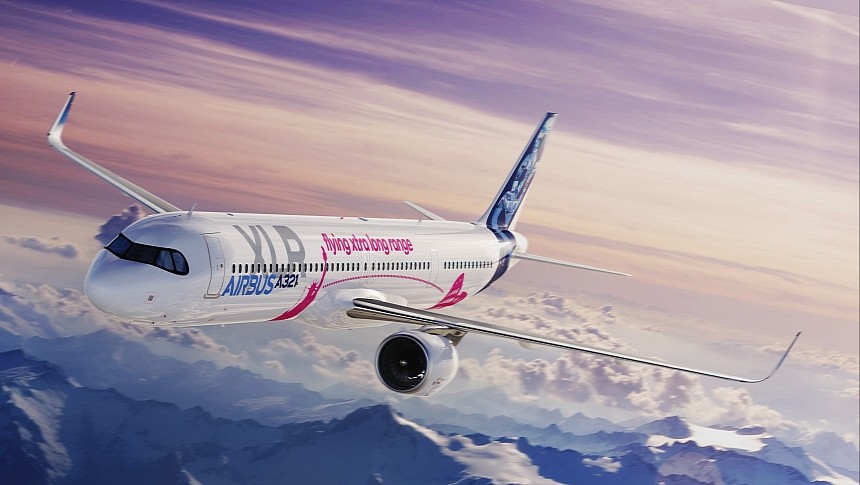Airbus has been on something of a tear since the start of the 2020s. As their rivals at Boeing struggle even now with the PR nightmare of the 737 Max, Airbus has finally managed to outsell their American rival with 676 aircraft delivered compared to just 480 for Boeing in 2022. But don't expect Airbus to let its foot off the proverbial gas any time soon. The A321XLR is coming any day, and the civil aviation space is taking notice; here's why you should too
First unveiled back at the 2019 Paris Air Show, the A321XLR takes the standard A321 neo platform known to be Airbus' bread and butter and makes it even more efficient with a considerably longer range. Owing in no small part to its smaller seating density compared to the standard A321 neo, Airbus started the modifications to the A321XLR airframe by enlarging its already massive center fuel tank under the fuselage. With less passenger capacity and, therefore, far less weight to lug around, Airbus anticipates the A321 XLR will boast a range of at least 4,700 nautical miles (8,300 km; 5,200 mi).
All the while, the A321 XLR will be powered by either CFM LEAP-1A or the Pratt & Whitney PW1100G turbofan engine. It's a prospect that's all too enticing for global airlines flying international routes. As first noted by simpleflying.com, a number of global airlines have already placed their orders for the new long-range, single-aisle jet from Airbus. As you'll find, such a niche, ultra-long-range jet is finding manages to find a wide degree of appeal among a host of unique airlines with different needs and requirements. For instance, India's most successful low-cost airline, IndiGo, will introduce a fleet of 69 A321XLRs as a part of its larger deal for an astonishing 500 aircraft in the A320 lineage.
Meanwhile, on the other side of the world, American Airlines appears equally infatuated with Airbus' new long-range twin jet. Having placed an order for 50 airframes back when the A321XLR was first introduced in Paris, the second-largest airline company in the world by gross revenue expects to take its first deliveries of the new jet as early as next year. With as many as 350 unique destinations to fly to, more than any other air carrier in the world, American Airlines would perhaps have the most to gain from a large fleet of A321XLRs to supplement its fleet of 50 Boeing 737 Max 8s.
At the same time, American Airlines' Australian analog, Qantas, has a similar strategy. At the same Paris Air Show where AA placed their order for the A321XLR, Qantas ordered 20 of their own to service their long-haul routes from Australian soil to destinations in East Asia. With other big-name airlines like Icelandair, Air Canada, and Air Arabia, among others, also expecting deliveries of the A321XLR next year, it's bound to be another banner year for Airbus in the civilian space. In spite of recent reports from Reuters detailing how the A321XLR's range isn't quite up to the standards Airbus had hoped, it doesn't appear to have put even a small damper on an integral portion of Airbus' corporate plan for the rest of the 2020s.
If nothing else, as Boeing's reputation in the civil airliner space continues to tumble, Airbus, as well as other manufacturers like Embraer, have only increased their market presence. It's a trend that's unlikely to change anytime soon. In any case, a world without an effective monopoly on airline manufacturing is one that serves the flying public all the more efficiently.
All the while, the A321 XLR will be powered by either CFM LEAP-1A or the Pratt & Whitney PW1100G turbofan engine. It's a prospect that's all too enticing for global airlines flying international routes. As first noted by simpleflying.com, a number of global airlines have already placed their orders for the new long-range, single-aisle jet from Airbus. As you'll find, such a niche, ultra-long-range jet is finding manages to find a wide degree of appeal among a host of unique airlines with different needs and requirements. For instance, India's most successful low-cost airline, IndiGo, will introduce a fleet of 69 A321XLRs as a part of its larger deal for an astonishing 500 aircraft in the A320 lineage.
Meanwhile, on the other side of the world, American Airlines appears equally infatuated with Airbus' new long-range twin jet. Having placed an order for 50 airframes back when the A321XLR was first introduced in Paris, the second-largest airline company in the world by gross revenue expects to take its first deliveries of the new jet as early as next year. With as many as 350 unique destinations to fly to, more than any other air carrier in the world, American Airlines would perhaps have the most to gain from a large fleet of A321XLRs to supplement its fleet of 50 Boeing 737 Max 8s.
At the same time, American Airlines' Australian analog, Qantas, has a similar strategy. At the same Paris Air Show where AA placed their order for the A321XLR, Qantas ordered 20 of their own to service their long-haul routes from Australian soil to destinations in East Asia. With other big-name airlines like Icelandair, Air Canada, and Air Arabia, among others, also expecting deliveries of the A321XLR next year, it's bound to be another banner year for Airbus in the civilian space. In spite of recent reports from Reuters detailing how the A321XLR's range isn't quite up to the standards Airbus had hoped, it doesn't appear to have put even a small damper on an integral portion of Airbus' corporate plan for the rest of the 2020s.
If nothing else, as Boeing's reputation in the civil airliner space continues to tumble, Airbus, as well as other manufacturers like Embraer, have only increased their market presence. It's a trend that's unlikely to change anytime soon. In any case, a world without an effective monopoly on airline manufacturing is one that serves the flying public all the more efficiently.
